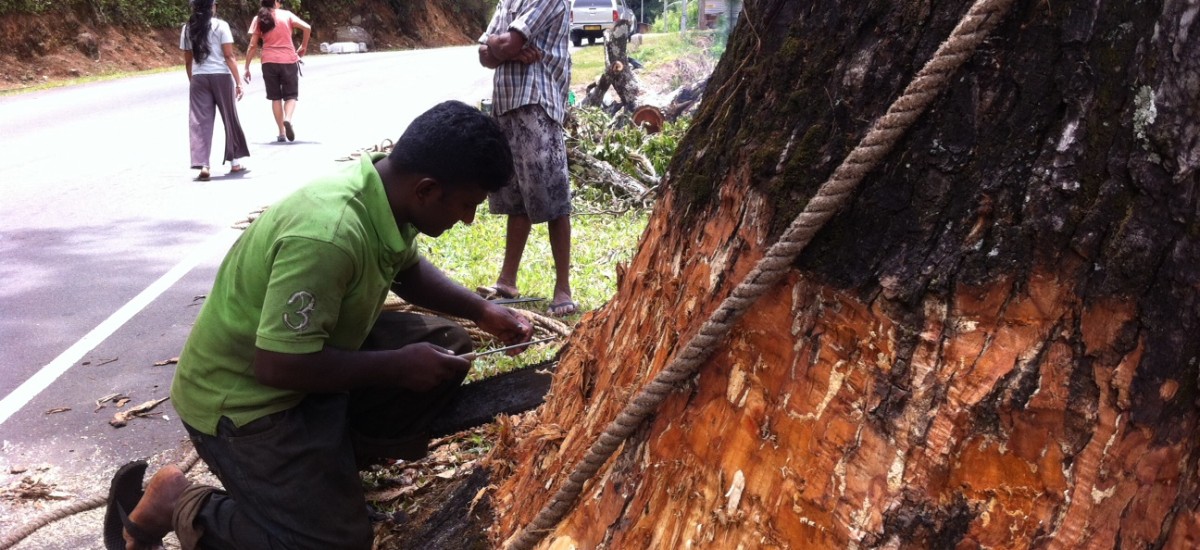Do you remember what a large tree looked like? Once they were all around us, not just the forest giants like the Hora or Palu, but the fine old Mango and Jak trees that would have taken at least four or five men to girdle.
The next time you leave the city on any road, look for those big trees and you will find that there are none. The only large trees that remain are the Rain trees planted for the comfort of the road users about a hundred years ago or the Bodhi trees planted for worship even earlier.
The home gardens, plantations and the stream reservations that once boasted the old giant trees have now lost them. This is not to say that there aren’t Mango trees or Jak trees in these parts.
To be sure, there are many: but the largest of the trees commonly seen in Sri Lanka today are about fifty to one hundred years from
Becoming a large tree of the size we were so familiar whit in our recent past.
If this is so, it will mean that the present generation and the next will not be able to experience a large tree. Further, if we do not arrest this destructive trend during our lifetime we rob the future of their right to the fruits of our forefathers.
As we read these words, the axemen and the highly modern chainsaw operators fell the last of the giant trees with gay abandon, for today, care and concern has been replaced with profit and expediency. The case of the Rain tree is a classic example.
The rain tree (Samanea saman) is familiar to most of us as the large umbrella shaped Mara tree that line many of our roadways. It was originally introduced from Venezuela in about 1850 and has now become naturalized in Sri Lanka. It was selected for roadside planting because of its habit of growing a wide canopy that afforded shade for the road users.
McMillan states “The importance of shade trees in the tropics is impossible to over estimate. They are in many cases essential to the successful cultivation of crops and a boon to man and beast on account of the shelter they afford from the fierce sun, as well as for their effect in tempering the atmosphere and conserving the moisture of the soil.’
This concern for the pedestrian and animal drawn traffic seems to have prompted planners of a hundred years ago to plant huge numbers of Mara trees by our roadsides. About twenty or thirty years ago a change seems to have come upon the planners. They began to stop the practice of extensive roadside plantings.
In fact, if one examines our roadside Mara trees is hard to find any young trees of a decade or so in age. If this was not bad enough, over the last few years, they have begun to systematically cut down the large trees that were planted so many years ago.
For what reason, we may ask, are these trees being felled and by whom?. A major offender seems to be the Ceylon Electricity Board who sees the placement of power lines by roadsides their inalienable right.
Another is the Highways Department, busily expanding the roads for big development machines to move on. Underwriting all this is the fact that old Mara trees give a very valuable timber that is presently substituted for Nedua (Percopsis mooniana) in furniture making.
The plight of the poor road user who does not own a car is not considered. The inability of the pedestrian, bullock cart operator and cyclist to use the road at mid-day once this shade is removed is not a factor to be reckoned with.
When we consider the fact that no replacement plantings are made, to render the now developed roads to be comfortable for the poorer part of our society, one wonders about the sensitivity of the present planners to the basic needs of the larger part of our society.
Even if we reject concern for the comfort of the poorer part of our society as “bleeding heart liberalism” do we not value any of our heritage to pass it on to our children?. For, the giant trees, like whales, are wonders of nature. We may condone the felling of some, while they were abundant around us.
But when they have become so rare as to warrant a journey of many miles to see one, their conservation should be an obligation to the next generation.
Do we have a single person in the decision-making bureaucracy who will act to slow the destruction of our large trees? Will someone begin to catalogue what we have left and where?. Or, will they all stand by, pass the buck and say “not my responsibility” or connive with some corrupt politician and treat us to the dubious pleasure of watching the axeman at our roadsides ?. As for exmple, what is happening on the Haldmulla road today. Where oh where are the environmentalists and tree lovers of this nation ?




